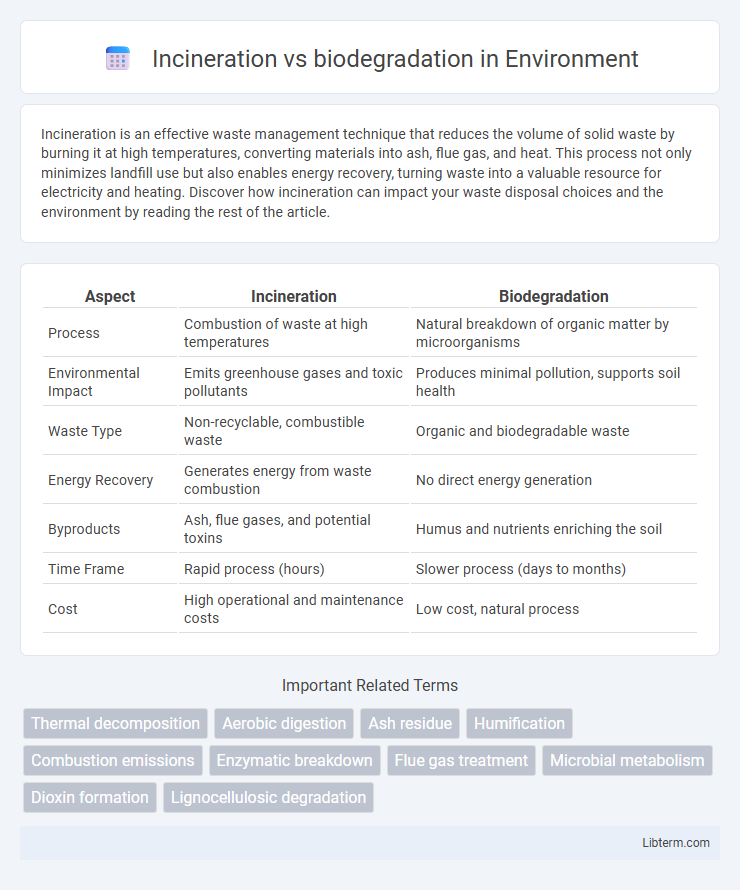Incineration is an effective waste management technique that reduces the volume of solid waste by burning it at high temperatures, converting materials into ash, flue gas, and heat. This process not only minimizes landfill use but also enables energy recovery, turning waste into a valuable resource for electricity and heating. Discover how incineration can impact your waste disposal choices and the environment by reading the rest of the article.
Table of Comparison
| Aspect | Incineration | Biodegradation |
|---|---|---|
| Process | Combustion of waste at high temperatures | Natural breakdown of organic matter by microorganisms |
| Environmental Impact | Emits greenhouse gases and toxic pollutants | Produces minimal pollution, supports soil health |
| Waste Type | Non-recyclable, combustible waste | Organic and biodegradable waste |
| Energy Recovery | Generates energy from waste combustion | No direct energy generation |
| Byproducts | Ash, flue gases, and potential toxins | Humus and nutrients enriching the soil |
| Time Frame | Rapid process (hours) | Slower process (days to months) |
| Cost | High operational and maintenance costs | Low cost, natural process |
Introduction to Waste Management Methods
Incineration and biodegradation represent two fundamental waste management methods with distinct environmental implications. Incineration involves the combustion of waste materials at high temperatures, reducing volume significantly and producing energy but also emissions requiring control. Biodegradation relies on natural microbial processes to decompose organic matter, promoting nutrient recycling and minimizing landfill use through composting and other biological treatments.
Defining Incineration and Biodegradation
Incineration is the high-temperature combustion process used to convert waste materials into ash, flue gas, and heat, effectively reducing waste volume while generating energy. Biodegradation refers to the natural breakdown of organic substances by microorganisms such as bacteria and fungi, resulting in simpler compounds like carbon dioxide, water, and biomass. Unlike incineration, biodegradation relies on biological activity and occurs under aerobic or anaerobic environmental conditions.
Mechanisms of Incineration
Incineration eliminates waste by combusting organic materials at high temperatures, converting them into ash, flue gases, and heat through oxidation reactions. This process breaks down complex molecules rapidly, unlike biodegradation, which relies on microbial activity to decompose materials over extended periods. Incineration's efficiency depends on temperature control, oxygen supply, and residence time to ensure complete combustion and minimize harmful emissions.
How Biodegradation Works
Biodegradation is the natural process where microorganisms such as bacteria, fungi, and algae break down organic materials into simpler substances like water, carbon dioxide, and biomass through enzymatic reactions. This eco-friendly mechanism relies on aerobic or anaerobic conditions to decompose waste, promoting nutrient recycling in ecosystems. Unlike incineration, which combusts waste at high temperatures producing emissions, biodegradation offers a sustainable solution for organic waste management by minimizing environmental impact.
Environmental Impact: Incineration vs Biodegradation
Incineration significantly reduces waste volume but emits greenhouse gases and toxic pollutants, impacting air quality and contributing to climate change. Biodegradation leverages natural microbial processes to break down organic waste with minimal environmental harm, promoting soil health and carbon sequestration. Overall, biodegradation offers a more sustainable approach by minimizing emissions and supporting ecosystem balance compared to the high-energy and pollutant-intensive nature of incineration.
Energy Recovery in Waste Treatment
Incineration enables significant energy recovery by converting waste into heat and electricity through combustion, making it a reliable method for reducing landfill usage. Biodegradation, while environmentally beneficial by breaking down organic waste into natural elements, generates minimal usable energy compared to incineration. Energy recovery efficiency in incineration is typically between 20-30%, whereas biodegradation processes such as anaerobic digestion can harness biogas with lower energy output and longer processing times.
Greenhouse Gas Emissions Comparison
Incineration releases significant amounts of CO2, methane, and nitrous oxide, contributing heavily to greenhouse gas emissions, whereas biodegradation typically produces lower emissions dominated by methane and CO2 in more controlled amounts during organic waste decomposition. Modern incineration facilities equipped with advanced gas-cleaning technologies can reduce pollutant release but still emit more greenhouse gases compared to natural biodegradation processes. Biodegradation's carbon footprint varies with conditions such as oxygen availability, making it less consistent but generally more environmentally favorable for reducing long-term greenhouse gas impacts.
Suitability for Different Waste Types
Incineration is highly suitable for hazardous, medical, and non-biodegradable waste due to its ability to reduce volume and eliminate pathogens through high-temperature combustion. Biodegradation excels with organic waste such as food scraps, yard waste, and paper, relying on microbial activity to break down materials naturally. While incineration addresses a broad range of waste quickly and with energy recovery potential, biodegradation is preferred for environmentally friendly disposal of biodegradable materials that contribute to soil health.
Economic and Infrastructure Considerations
Incineration requires significant capital investment in advanced facilities and ongoing operational costs, often justifiable in urban areas with high waste volumes, while biodegradation processes demand less infrastructure but longer timeframes and depend on suitable environmental conditions. Economically, incineration can generate energy and reduce landfill expenses, offsetting some costs, whereas biodegradation offers lower immediate expenses but may incur higher land use and monitoring costs. Infrastructure for incineration involves complex emissions control systems, whereas biodegradation relies on composting sites or bioreactors, influencing scalability and location flexibility.
Future Trends in Sustainable Waste Management
Incineration technology is increasingly being optimized for energy recovery and emission reduction, supporting circular economy goals by converting waste into renewable energy. Biodegradation advancements emphasize engineered microbial consortia and enzymatic treatments that accelerate organic waste decomposition, reducing landfill dependency and greenhouse gas emissions. Future sustainable waste management integrates hybrid systems that combine incineration for non-biodegradable waste and biodegradation for organic fractions, enhancing resource efficiency and environmental impact mitigation.
Incineration Infographic

 libterm.com
libterm.com